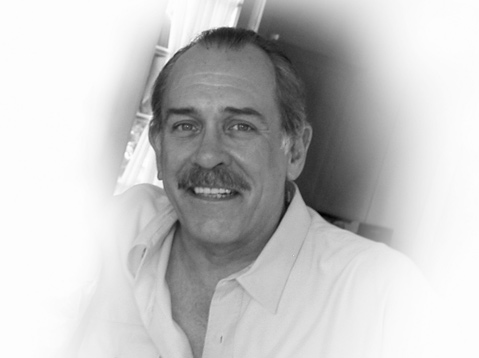
Thomas Steinbeck died on August 11 after 72 years of art, adventure, and love. Thom was born in New York City to Gwyndolyn and John Steinbeck on August 2, 1944. His mother encouraged an awareness of artistic expression; his father helped him develop an appreciation for language, literature, and the human experience; and his younger brother, Johnny, made sure he had a lot of fun.
As a young man, Thom’s studies at Chouinard Art Institute and UCLA film school were cut short by the Vietnam War. Arriving in Vietnam on the second day of the Tet Offensive, Thom was assigned to serve as a helicopter door-gunner and later reassigned to his original posting as a television production specialist for American Forces Vietnam Network. After his service, he returned to Southeast Asia as a journalist and photographer. Like most veterans, his war experience left long-lasting and deep scars, but his new life as a writer and raconteur had begun.
When he returned to the U.S., Thom studied at the Naropa Institute with its founder, Chögyam Trungpa Rinpoche, who told him he was already an enlightened soul, that everything he was teaching him he already knew. Recounting this to his dear friend Diana Raab over a tequila and soda at Pierre Lafond, Thom credited Buddhism for changing his life, saying, “I no longer had to make any pronouncements. I simply knew my instincts were right.”
For the next 20 years, Thom wrote for and crewed on a number of documentary, film, and television projects, selling original scripts as well as adaptations of his father’s books. Thom was a brilliant and talented writer, but being the son of a famous writer was a mixed blessing: In Monterey, perfect strangers would ring his doorbell; everything he did was scrutinized in the context of his father. Thom moved to Los Angeles in 1994 while writing a screenplay for Hollywood Pictures, but he fell in love with Santa Barbara County and began to call Santa Barbara home in 2002.
Over the years, Thom served on the board of directors for both the National Steinbeck Center in Salinas and the Center for Steinbeck Studies at San Jose University. Each year he presented the John Steinbeck Award, given to those who honored his father’s commitment to the dignity of common people; among the honorees were Bruce Springsteen, Joan Baez, Michael Moore, and Rachel Maddow. Thom was drawn to people who were authentic, committed, and talented. His friends included fishermen and craftsmen, artists and writers, chefs and bartenders, historians and collectors, stoners and scholars.
With a disdain for injustice in any form, Thom and his wife, Gail Knight Steinbeck, went to court to assert the blood heirs’ rights to John Steinbeck’s intellectual property and legacy under the Federal Copyright Act. This battle led to the formation of the Artists Rights Coalition — a nonprofit foundation established to help all artists understand and protect their intellectual property. In Thom’s words: “You cannot say you support the arts unless you support the artists’ right to support themselves.” The Steinbecks were also avid advocates for the Nuclear Age Peace Foundation, the Southern Poverty Law Center, and the well-being of all veterans.
As anyone who spent time with him can attest, Thom was a positive, thinking person who intuitively saw what was unique and worthy in others. He was generous with his praise and his time, regaling listeners with galloping stories about the Chinese who settled the California coast, adventures as a wartime reporter, worldly travels, and encounters with interesting people. He often peppered his delivery with anecdotes and quotes from his father.
Thom was a successful author of several books set in the colorful history of California’s Central Coast, including In the Shadow of the Cypress and The Silver Lotus. Recently, Thom recounted one of the tales in Down to a Soundless Sea to entice his buddy, Benjamin Brode, into the woods to paint. This resulted in a beautiful, fanciful collaboration between writer and artist and the book In Search of the Dark Watchers.
In his later years, the effects of Agent Orange and years of smoking resulted in chronic obstructive pulmonary disease, necessitating his use of portable oxygen. Gail set up in a charming suite for Thom on the south side of the house, and the space quickly filled with his “toys” — model-making tools, ships on the wall, and airplanes hung from the ceiling. Although this was a private wing, the flow of life coursed through these rooms with dear friends, family, neighbors, dogs, and children, all sharing their deep love for Thom.
Being with Thom was akin to witnessing the story line of an interesting novel … of a Southern persuasion. There was his deep and romantic relationship with the love of his life, the Southern belle and rabble-rouser Gail. There was the multigenerational link to the Guthrie clan. There was the drama of a complicated family and feasting on roast beef and Yorkshire pudding prepared by Thom with precision. There was the port and tequila. We will miss the twinkle in his blue eyes, the warmth of his heart, and his recognition of the things that mattered. But, as Gail said after his transition, “I watched Thom heading home tonight, transported by the Perseid meteor shower. No wonder he left so quickly — he couldn’t wait.”
The unique human being that was Thomas Steinbeck will live forever in the hearts of those who knew and loved him.
More can be found about Thomas Steinbeck’s books, life, and causes at thomassteinbeck.com. Donations honoring him can be made through artistsrightscoalition.org.
